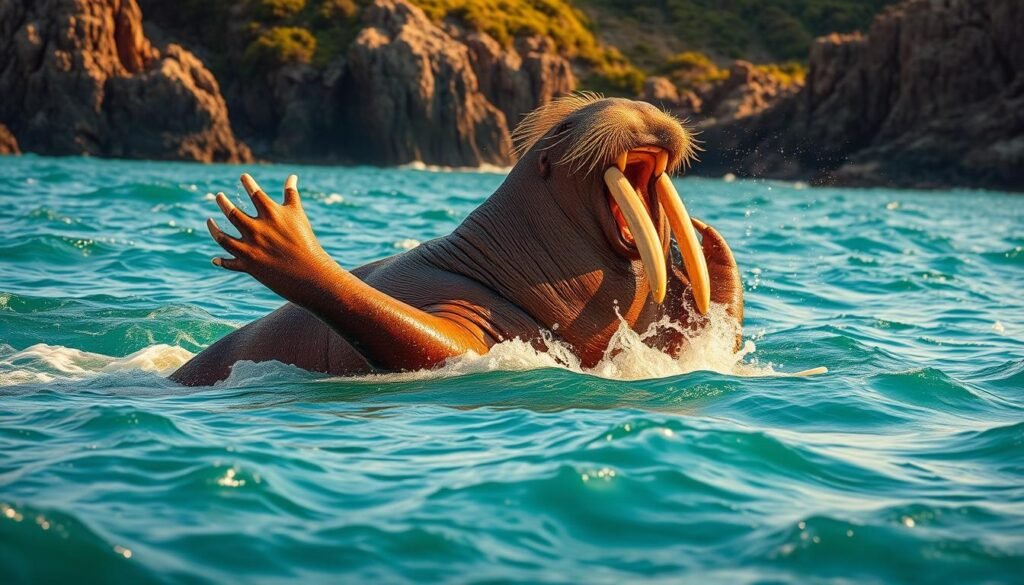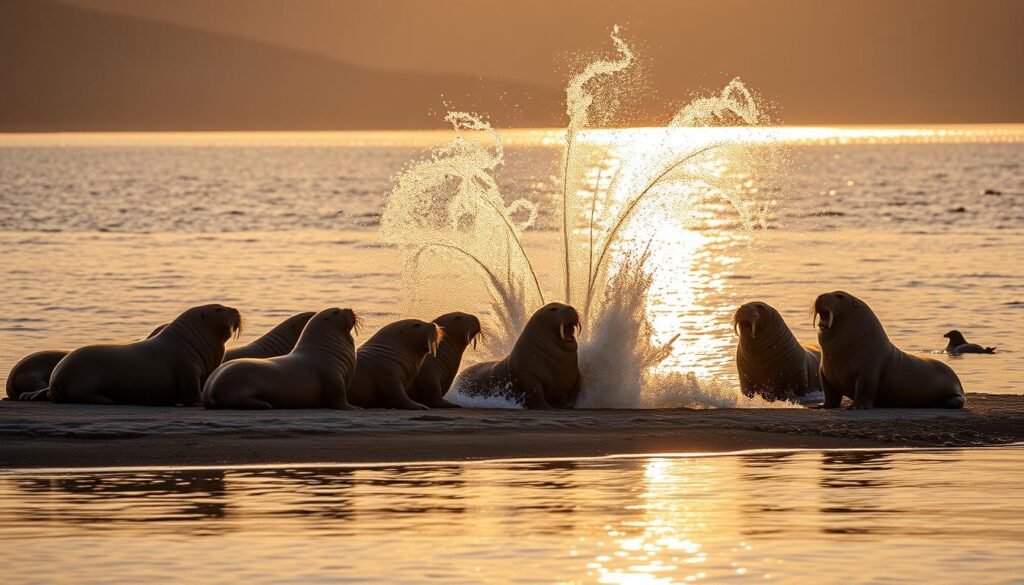Why Walruses Slap Water with Flippers? Have you ever seen walruses slapping the water with their flippers? It’s quite a sight. But what makes them do it?
Walruses are amazing marine mammals with interesting habits. Their actions are a blend of talking, socializing, and adapting to their world.
Learning about walruses can show you their social lives and how they fit into their environment. Knowing about their behavior helps us understand these creatures better and their role in the ocean.
Contents
- 1 The Fascinating World of Walruses
- 2 Why Do Walruses Slap Water with Flippers?
- 3 The Science Behind Walrus Water Slapping
- 4 Other Notable Walrus Behaviors and Adaptations
- 5 Understanding Walrus Behavior and Adaptations
- 6 FAQ: Why Walruses Slap Water with Flippers?
- 6.1 What is the main reason walruses slap water with their flippers?
- 6.2 How do walruses use their flippers to create the slapping sound?
- 6.3 What role do tusks play in walrus social hierarchy?
- 6.4 How do walruses adapt to their Arctic environment?
- 6.5 What is the significance of mother-calf relationships in walruses?
- 6.6 How do walruses interact with each other on ice and land?
- 6.7 What do walruses primarily feed on?
The Fascinating World of Walruses
Exploring the Arctic, you’ll meet the walrus, a key Arctic icon. These large marine mammals live in the icy Arctic. They thrive in shallow waters, eating clams, mussels, and more.
Walruses live in groups, often on ice or rocky shores. These gatherings help them survive. They offer protection and chances for mating. [Why Walruses Slap Water with Flippers?]
Walruses are known for their tusks, used for defense and hauling out of water. They also have thick blubber to stay warm in cold.
- Walruses use their whiskers to find food on the ocean floor.
- They eat a lot, storing energy for when food is scarce.
- They communicate through sounds and body language.
Learning about walruses helps us understand the Arctic. It shows how changes affect these amazing animals. [Why Walruses Slap Water with Flippers?]
Why Do Walruses Slap Water with Flippers?
When you watch walruses in their home, you might see them hitting the water with their flippers. This isn’t just a simple move. It’s a way for them to talk and connect with each other.
They slap the water for a few reasons. One is to warn other walruses about dangers or food nearby. This helps them stay safe and find food together. [Why Walruses Slap Water with Flippers?]

Slapping their flippers is a key way for walruses to communicate. They send messages to each other without making a sound. This is very important for their social life.
Possible Explanations for Walrus Water Slapping
- Warning other walruses of potential threats
- Signaling the presence of food
- Part of their social interaction and communication
The table below shows why walruses slap the water and why it matters.
| Reason | Significance |
|---|---|
| Warning Signal | Alerts other walruses to potential threats |
| Food Signaling | Indicates the presence of food sources |
| Social Interaction | Facilitates communication among walruses |
Learning about walruses slapping the water helps us understand their complex lives. By studying their behavior, we can appreciate these amazing creatures more.
The Science Behind Walrus Water Slapping
To grasp the science of walrus water slapping, we must look at their flippers and how sound is made. Walruses, being large marine mammals, have special features that help them behave uniquely.
The flipper anatomy of a walrus is key to their slapping. Their flippers are strong, thanks to muscles and tendons. This strength lets them slap the water hard, making a loud noise. [Why Walruses Slap Water with Flippers?]
The physics of this sound comes from water displacement. When a walrus slaps the water, it makes a shockwave. This shockwave travels through the water, creating the sound we hear.
Key Factors Influencing Walrus Water Slapping
| Factor | Description | Impact on Slapping Behavior |
|---|---|---|
| Flipper Anatomy | Robust muscles and tendons | Enables powerful slapping |
| Water Density | Varies with temperature and salinity | Affects the sound propagation |
| Slapping Speed | Speed at which the flipper hits the water | Influences the loudness of the sound |
Understanding these scientific principles helps us see the complexity of walrus behaviors. Their adaptations as marine mammals are perfectly suited to their environment. This makes their behaviors both captivating and enlightening.
Other Notable Walrus Behaviors and Adaptations
Walruses live in complex social groups with interesting behaviors and adaptations. As Arctic animals, they have evolved unique ways to survive and thrive in their harsh environment.
Walrus tusks are key in showing who’s in charge in their groups. Longer tusks often signify dominance, and are used in power displays and conflicts. [Why Walruses Slap Water with Flippers?]
Tusk Use in Everyday Activities
Tusks are also used in daily tasks. Walruses use them to pull themselves out of the water, defend against predators, and create breathing holes in ice.
Herd Dynamics on Ice and Land
Walruses are very social and often gather in large groups on ice and land. These gatherings involve complex behaviors like vocalizations, body language, and physical interactions.
Mother-Calf Relationships
The bond between a mother walrus and her calf is very strong. Mothers are protective and nurturing, going to great lengths to keep their calves safe and well.
Some key aspects of walrus behavior include:
- Vocalizations to communicate
- Use of body language to convey information
- Cooperative behavior within herds
Understanding these behaviors and adaptations gives us valuable insights into these fascinating Arctic animals.[Why Walruses Slap Water with Flippers?]
Understanding Walrus Behavior and Adaptations
You now know more about walruses and their unique ways, like slapping water with their flippers. This action is key for their communication and social life. By looking into the science of walrus water slapping, you’ll see how they adapt to live in the Arctic.
Walrus behavior and adaptations are closely connected. Their special looks and social ways help them survive. As you learn more about walruses, you’ll value these amazing animals and the need to protect their homes.
See Also: Koalas Sleep Up to 22 Hours a Day – Here’s Why
FAQ: Why Walruses Slap Water with Flippers?
What is the main reason walruses slap water with their flippers?
Walruses slap water with their flippers for communication and warning. They also use it for social interactions.
How do walruses use their flippers to create the slapping sound?
Walruses slap the water’s surface with their flippers. This creates a loud noise that can be heard for miles. It’s likely used for communication or warning other walruses.
Tusks are key in walrus social hierarchy. Larger tusks often mean higher status and dominance. [Why Walruses Slap Water with Flippers?]
How do walruses adapt to their Arctic environment?
Walruses adapt to the Arctic with thick blubber. This keeps them warm in cold temperatures. They also dive deep to find food.
What is the significance of mother-calf relationships in walruses?
Mother-calf relationships are vital in walruses. Mothers care for and protect their calves. They teach them survival skills and social behaviors.
How do walruses interact with each other on ice and land?
Walruses gather in large herds on ice and land. They communicate through vocalizations, body language, and physical contact. This helps maintain social bonds and establish hierarchy.
What do walruses primarily feed on?
Walruses are carnivores and mainly eat clams, mussels, and other marine mollusks. They use their sensitive whiskers and powerful snouts to find food on the seafloor.

Zyair Larson, based in Denver, Colorado, has over 12 years of experience studying animal behavior. He has worked with the World Wildlife Fund (WWF) and National Geographic, researching wildlife and sharing insights on animal habits globally.

